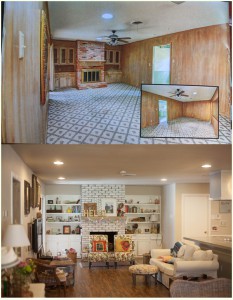 Whether you’re looking to move in the next few years or at some unknown point down the road, if you own an older home, it can be challenging to think about entering a housing market that is frequently flooded with new builds. While there’s something to be said for the quality and integrity of older building materials, as well as the character that comes with etched woodwork and crown molding, if your home was built in the 60s or 70s, chances are good that it’s missing that old-time charm anyway.
Whether you’re looking to move in the next few years or at some unknown point down the road, if you own an older home, it can be challenging to think about entering a housing market that is frequently flooded with new builds. While there’s something to be said for the quality and integrity of older building materials, as well as the character that comes with etched woodwork and crown molding, if your home was built in the 60s or 70s, chances are good that it’s missing that old-time charm anyway.
What you will find, however, are things like wood paneling, dark flooring, dim lighting, and an abundance of popcorn ceilings. In essence, things tend to feel a bit tight. Therefore, if you’re looking to bring a home that’s 40 to 50-years-old into this century, a few tweaks can make a great deal of difference.
GET RID OF DARK PANELING
Homes in this era tend to have lower ceilings which, combined with darker wall coverings, often make people feel as if they’re living in a cave. To really make things feel open and light, one of the first considerations should involve removing the dark paneling. While this process definitely requires a bit of effort, it will be well worth it in the end. If you’re extremely handy or have experience with this type of renovation, it’s certainly a project that can be done without professional help; however, depending upon the condition of your walls beneath the paneling, additional assistance may be required.
If you don’t have the time or money to remove the paneling all-together, consider painting over it with a light color.
BRING IN THE LIGHT
Since low ceilings tend to restrict the amount of light that comes into your home, a great remedy involves the installation of a few skylights. While this is another project that you may be able to do on your own, it’s probably wise to hire the services of a professional. Not only can they help make sure the installation is done right—you certainly don’t want rain leaking in—they can help you select the right type of skylights for your home, as well as your budget.
ADDING WINDOWS
Although replacing your existing windows may go a long way towards making your home feel a bit more modern, especially if they’ve become drafty over the years, part of allowing more light into your space may simply involve adding additional windows to certain rooms.
Clearly, this is generally a job for a professional, especially if you’re planning on adding windows or expanding existing ones. Anytime you mess with your walls, it’s important to have a solid understanding of where your structural supports are, so making sure this project is done correctly is pretty important.
REPLACE YOUR FLOORING
Whether you’re dealing with carpeting, tile, or wood flooring, you’ll add more appeal to your home by replacing any dark flooring with lighter alternatives. Consider swapping dark carpeting with lighter, more muted tones (e.g. beige, grey, off-white, etc.) and refinish any dark-stained wood with a lighter stain. If you have an abundance of dated vinyl flooring, you may want to opt for a pale colored tile instead.
SAY GOODBYE TO THE POPCORN CEILINGS
Most homes built during the 60s and 70s have popcorn ceilings, which have a tendency to cause shadows and trap dust. With that, no matter how well you renovate the rest of your home, they will always scream, “I was built in 1973!” Therefore, updating your ceilings is wise investment and is something that doesn’t necessarily require the services of a professional painter. Most people are entirely capable of doing it themselves; however, aside from being messy, it requires the use of certain tools that you simply may not have at home.
For tips on updating the curb appeal of your outdated home, stay tuned for next week’s blog. As always, if you would like advice or want to know what types of home changes will give you the best bang for your buck, please contact me. I’m always here to help.
Marie Dinsmore | The Dinsmore Team | www.DinsmoreTeam.com | 770-712-7789

 When it comes to real estate and most forms of housing, the Fair Housing Act creates a blanket of sorts that envelops those looking to purchase or rent a residence. In essence, while there are still stipulations, race, color, national origin, religion, sex, familial status, or disability cannot be a deciding factor in things such as refusing to rent or sell housing, set different terms or conditions, or deny a dwelling.
When it comes to real estate and most forms of housing, the Fair Housing Act creates a blanket of sorts that envelops those looking to purchase or rent a residence. In essence, while there are still stipulations, race, color, national origin, religion, sex, familial status, or disability cannot be a deciding factor in things such as refusing to rent or sell housing, set different terms or conditions, or deny a dwelling.

